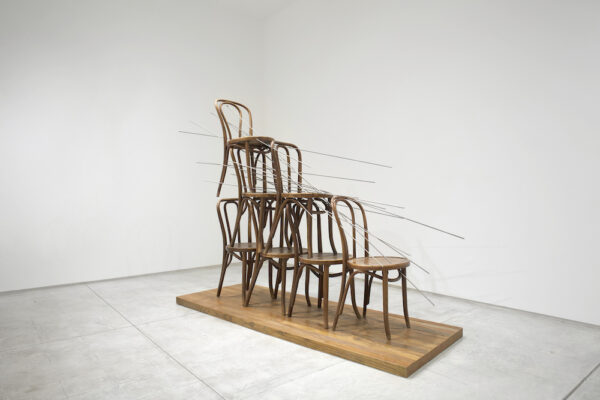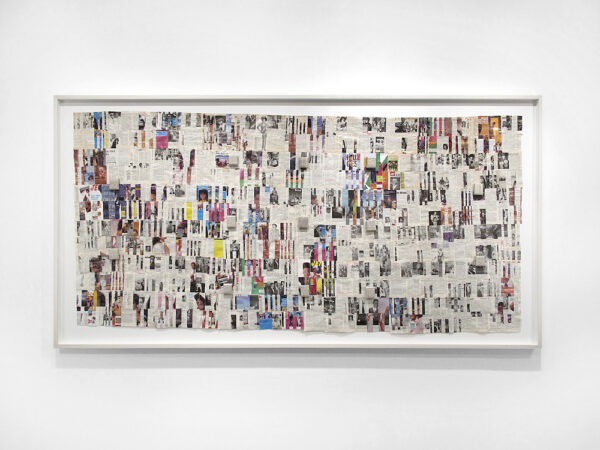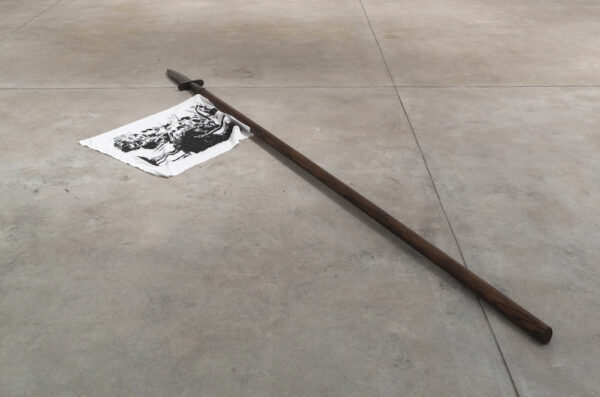
Jamal Cyrus, Untitled, 2010. Drum, leather, microphones, mic stands, cables, speaker. Image courtesy of the artist and Inman Gallery, Houston.
The late, great John Baldessari once said “I want to produce images that startle one into recollection.” It is a sentiment most artists can relate to. On the one hand, art needs to be accessible, approachable, somehow familiar if it is to be appreciated at all. However, every creator wants to leave her unique impression on the viewer. All art tells a story; bad art usually tells very bad stories, stories that don’t need to be told in the first place. But good art somehow invites the viewer into catharsis, and that viewer thereby ultimately gains something from the experience.
Artists want to startle the world with their unique vision, and this ultimately is the best qualifier of relevant work, of successful art. This is what makes it special — more than just another commodity. Art is a marker of shared experience through a singular filter. The recollection Baldesari speaks of is both collective and personal.

Jamal Cyrus, Lights from the Garden, 2019. Bentwood chairs, stainless steel rods, oak flooring. Image courtesy of the artist and Inman Gallery, Houston.
No artist, of course, lives in a vacuum. We reflect the lives we’ve led. Jamal Cyrus’s practice has developed a strategy over the years that dives headfirst into our troubled cultural waters. Perhaps every generation deems itself the most troubled, the most in need of reform and reflection, but today, this sentiment is in the spotlight with some renewed sense of urgency. Cyrus succeeds where many others do not in the sense that his art seldom loses touch with its grounding in a unique creativeness, rather than giving sway to something more didactic. Art can teach, it can inform and follow a pedagogy of sorts — but to be really good, it can never do these things in lieu of that underlying inspiration that can only be realized by an artist in touch with not only his environment, but more importantly, himself.
Much, if not all of the work in The End of My Beginning, Cyrus’ mid-career survey at the Blaffer Museum of Art in Houston, sees Cyrus navigating the turbulent waters of what it means to be an African-American in North America today, with all of the cultural signifiers that everyday existence presents to us in ways that we seldom think about. Cyrus, at his best, really does startle us. In Sargasso Sea, 2009, the artist creates an ensemble of objects that each bring to the table a certain meaning, but taken as a whole, achieve a profound presence. An eerie brain coral sits atop a percussive symbol (hi-hat) on top of a small pile of the titular flora. This is all mounted on top of a black-and-white patterned wedge of a platform, something resembling an abstracted Vans sneaker. Frankincense and myrrh incense are also in the mix for good measure. The number of interpretations one can get from the work is manifold, each element is loaded with meaning. The installation looks right in the sense that its presence in the gallery feels organic, like it is supposed to be there — as if it has some function beyond our understanding. And it does. When one reads about the materials and the artist’s intent, the work gets better. It talks about heavy issues like diaspora, forced migration and servitude. But it also talks about Cyrus’s love of American music and the culture that created it.
Another standout work is Texas Fried Tenor, a deep-fried saxophone mounted on top of a pedestal. The absurdity of the work immediately drew me in and the simple, unassuming presentation is spot on. It’s a residual product of an ongoing performance in which the artist refrys the instrument while reciting a poem based on the Texas tenor saxophone tradition. On the one hand, it speaks cleverly to the history of American jazz while also referencing stereotypes that surround its region of origin. Yet the presence of the object is so unexpected, it literally made me laugh out loud. How often does that happen in a museum show? Not enough, I would argue.

Jamal Cyrus, Jet Auto Archive–April 27, May 11, May 25, 1992 (Medicated L.A. Kente), 2018. Paper and cardboard collage. Private Collection.
The other works in the exhibition are just as carefully considered and researched. Indeed, the undercurrent of Cyrus’ oeuvre seems to be his personal experiences with (and meditations on) this complicated and messy culture we find ourselves in today. He has consistently made work that speaks to large, relevant and topical issues while still managing to startle. It is this personal filter that makes the show so timely, and valuable beyond the current zeitgeist.

Jamal Cyrus, Major & Minor, 2014. Wood, steel, fabric, silk screen, tacks. Image courtesy of the artist and Inman Gallery, Houston.
Yet another mark of good art is that it remains good even after its point of origin morphs into something new. Cyrus’s work will age well because he never neglects to share with us his personal whim in interpreting the cultural milieu it was made in. This allows us to be startled again and again by work that remains true to its inception and accurate to the artist. Even if we are not sure what we are to recollect. That remains, after all, a moving target from generation to generation. We feel a certain gravitas toward art like this — art that can expound as well as startle.
Through Sept. 19 at the Blaffer Art Museum, Houston.




